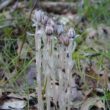Mayflower Flower Appearance
The mayflower is a low-growing ground cover that produces small, pinkish-white flowers in early spring and reaches a height of six inches. The flowers are borne on long, trailing stems and have five petals that are fused at the base. The leaves of the mayflower are evergreen and have a leathery texture. They are oblong in shape and have scalloped edges.
Mayflower Habitat and Distribution
The mayflower is a species of blooming plant that is native to North America. The plant gets its name from the abundant flowers that bloom in the springtime. The mayflower flower is most commonly found in woodlands, on acid soils. They are commonly found in Eastern United States and Canada.
Mayflower Blooming Season
The mayflower is a beautiful flower that blooms in the spring. It has a delicate white petal and a yellow center. During the blooming season, fields and meadows are filled with these pretty flowers.
Mayflower Care
Nigella flowers are delicate and beautiful, with a sweet fragrance that draws pollinators to them. They grow in shady areas and need special care to thrive. Here are some tips on how to take care of your mayflowers.
Water Requirements
The mayflower flower prefers well-drained soil and does not tolerate drought conditions. Mayflowers should be watered deeply and allowed to dry out between watering. Overwatering can cause the plant to rot.
Soil
They are well-suited to a variety of soil types, including sandy soil, loamy soil, and moist/wet soil. Mayflowers also prefer acidic soil with a pH level of 5.5 or lower. When planting mayflower flowers, it is important to amend the soil with compost or peat moss to ensure that the plants have adequate drainage.
Temperature
Although the mayflower is tolerant of a wide range of temperatures, it does best when the weather is cool. In warm climates, the plant can be damaged by heat and drought. As a result, gardeners in warm regions should take care to provide the mayflower flower with adequate moisture during the summer months.
Fertilizing
Mayflower flowers are relatively easy to care for and are not picky about soil type. However, they do require regular fertilization. A 10-10-10 fertilizer should be applied monthly from March through June. After the blooming period is over, mayflowers can be allowed to dry out somewhat before being watered again.
Light Exposure
Mayflowers prefer shady or dappled conditions and will not tolerate full sun. These plants make an excellent groundcover for shady areas of the garden.
Mayflower Flower: Pests
Although they are relatively resistant to pests and diseases, mayflowers can be susceptible to red spider mite and whitefly infestations. Red spider mites are tiny eight-legged creatures that feed on the sap of plants. They can cause the leaves of mayflowers to turn yellow and become mottled.
Whiteflies are small winged insects that feed on the sap of plants. They can cause significant damage to mayflowers, eventually leading to leaf drop. If you notice either of these pests on your mayflowers, it is important to take steps to control them as soon as possible.


















